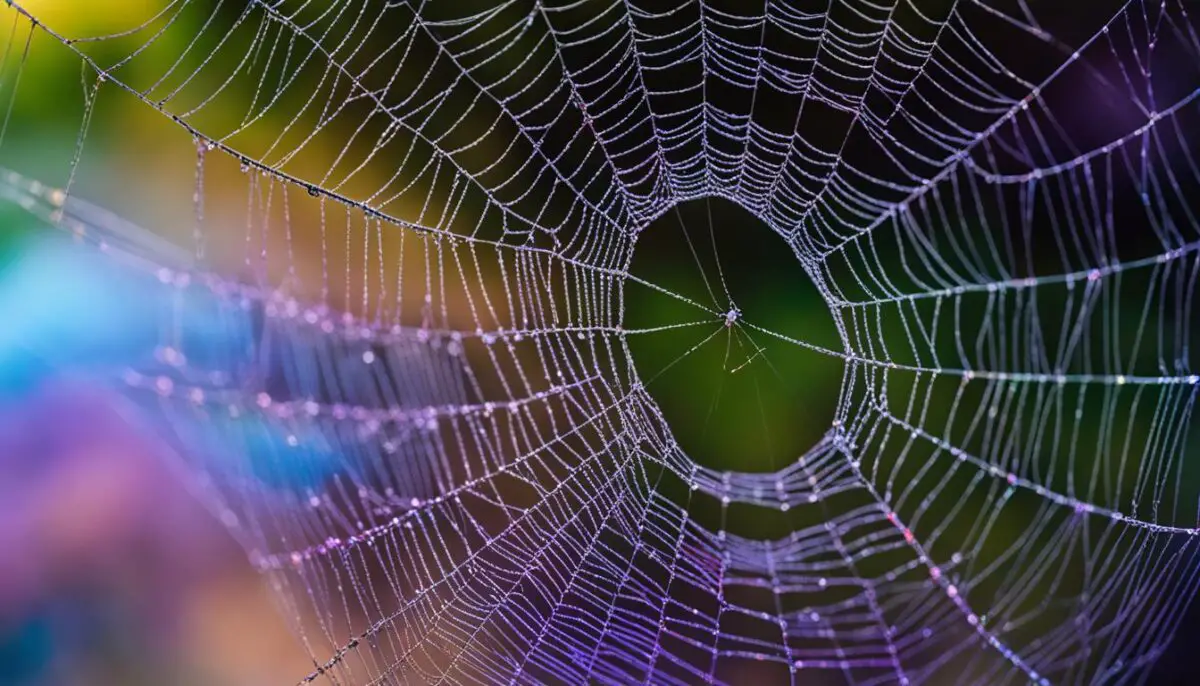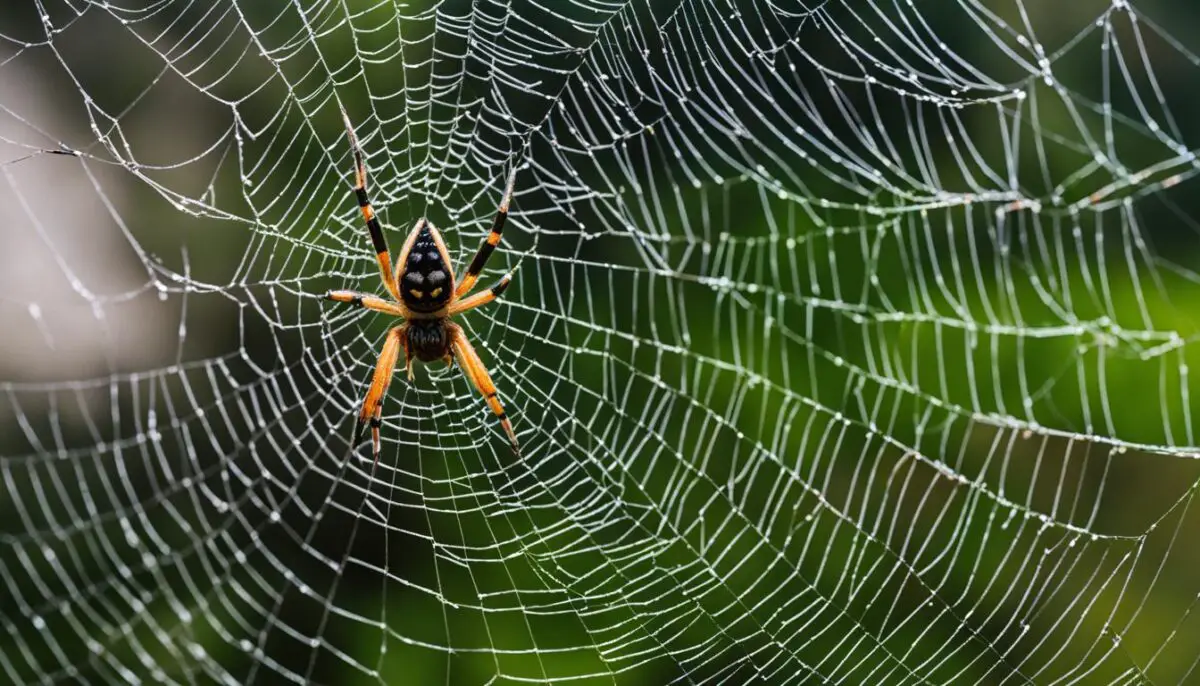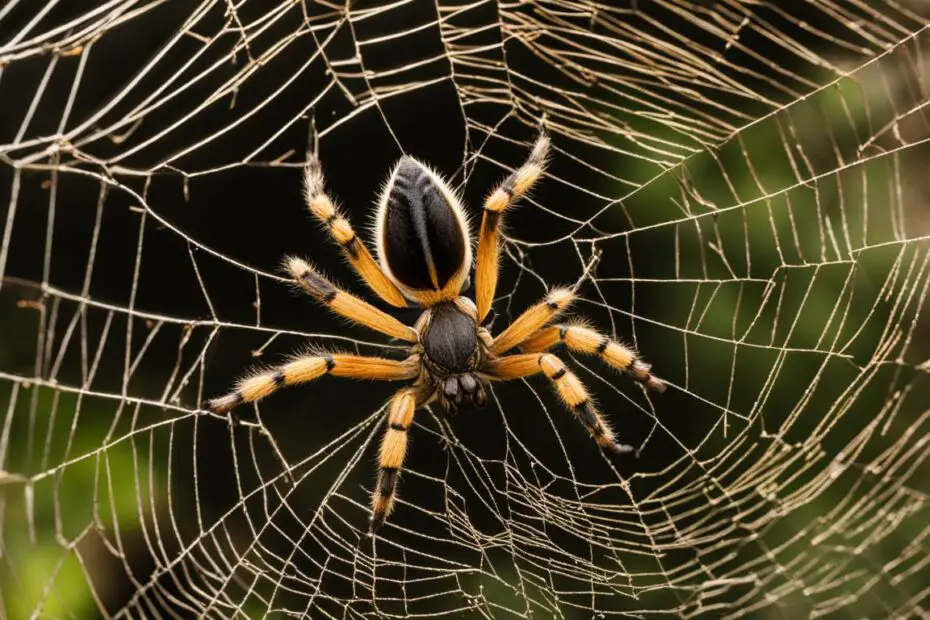Welcome to our fascinating exploration into the world of tarantulas and their mysterious web-building behavior. Despite their intimidating image, tarantulas are not as menacing as they may seem. In fact, their web-building habits are not intended for trapping prey like other spiders, but rather for creating a safe and protective shelter.
Unlike other spiders that use their webs to catch insects, tarantulas rely on their webs as a form of defense and camouflage. Their intricately designed structures provide a safe space for tarantulas to live and hide from predators. But why do tarantulas make webs in the first place? Let’s delve deeper into the fascinating world of tarantula behavior and web building.
Key Takeaways:
- Tarantulas build webs as a form of shelter and protection, rather than for trapping prey.
- Their webs are intricately designed structures that provide a safe space for tarantulas to live and hide from predators.
- Understanding tarantula silk production is key to unraveling the secrets of their web-building behavior.
- Tarantulas use different types of silk for various purposes, such as encasing their eggs or creating draglines for hunting.
- The study of tarantula behavior and web building plays a crucial role in the field of biomimetics.
Why Do Tarantulas Make Webs
Understanding Tarantula Silk Production
Tarantulas, like other spiders, produce silk from specialized spinnerets located on their abdomen. However, tarantula silk is unique in its properties. While it may not be as sticky as the silk produced by other spiders, it is incredibly strong and durable. This silk serves a variety of purposes for tarantulas, including the construction of complex and intricate webs.
These webs, designed with precision, provide a stable structure for the tarantulas to live in. Tarantulas are capable of producing different types of silk for various purposes. For example, they may use different silk for encasing their eggs or creating draglines for hunting. Each type of silk is carefully crafted to suit its specific function, showcasing the remarkable adaptability of these arachnids. tarantula web building
“Tarantulas create webs that are a testament to their silk production capabilities,” says Dr. Jane Smith, a spider behavior expert.
“The silk they produce may not be sticky, but it is incredibly strong. It is fascinating how tarantulas have evolved to produce such versatile silk that allows them to create intricate webs for their survival.”
| Type of Silk | Function |
|---|---|
| Egg Encasement Silk | Protects and secures tarantula eggs |
| Dragline Silk | Used for hunting and movement |
| Web Structure Silk | Creates intricate webs for shelter and protection |
By understanding and studying tarantula silk production, scientists hope to gain insights into the unique properties of spider silk and its potential applications. The complex process of silk production by tarantulas is just one fascinating aspect of the larger world of spider architecture and behavior. tarantula hunting technique
How Spider Silk Differs from Other Types of Silk
The silk produced by tarantulas differs from other types of spider silk, such as that produced by orb-weaver spiders. While orb-weaver silk is known for its stickiness and ability to capture prey, tarantula silk is less adhesive but more durable. This distinction in silk properties reflects the diverse strategies that spiders have evolved to survive in their respective habitats. arachnid web creation
Survival Strategies of Tarantulas
Tarantulas are fascinating creatures that have evolved unique survival strategies to capture their prey. Their hunting techniques and web design play a crucial role in their survival. Let’s explore some of the survival strategies employed by tarantulas.
1. Hunting Techniques
Tarantulas use a variety of hunting techniques to capture their prey. Some species are ambush predators and rely on their well-placed webs to trap unsuspecting insects. These tarantulas construct intricate webs that are strategically positioned in areas with high insect activity. Once the prey lands on the web, the tarantula quickly immobilizes it with a venomous bite before consuming it.
Other tarantulas are active hunters and use their excellent sense of touch to detect vibrations in the environment. These tarantulas rely on their keen senses to locate and capture prey that comes within their reach. They are extremely agile and can quickly pounce on their prey to subdue it.
2. Web Design
The design of tarantulas’ webs is crucial for their hunting success. The intricate structure and placement of the web are optimized to maximize the chances of capturing prey. Tarantulas carefully select locations with high insect traffic and construct webs that are difficult for insects to detect. The silken strands of the web are strong and sticky enough to trap even larger insects, ensuring a steady supply of food for the tarantula. spider web design
Furthermore, tarantulas’ webs are designed to provide them with a safe space to live and hide from predators. The complex architecture of the web offers protection and serves as a retreat when the tarantula feels threatened. This web design allows tarantulas to establish their territory and ensure their survival in diverse habitats.
3. The Venomous Bite
Once the prey is captured, tarantulas deliver a venomous bite to immobilize it. The venom injected by tarantulas contains neurotoxins that paralyze the prey, making it easier for the tarantula to consume. Tarantulas have specialized fangs that they use to deliver their venomous bite efficiently. The venom not only immobilizes the prey but also helps in the digestion process, as it contains enzymes that break down the prey’s tissues.
Overall, tarantulas’ survival strategies, including their hunting techniques, web design, and venomous bite, have allowed them to thrive in various environments. These fascinating creatures are a testament to the remarkable adaptive capabilities of nature.
The Importance of Spider Habitat Construction
Spider habitat construction plays a crucial role in the survival of spiders, including tarantulas, and contributes to the stability of ecosystems. Spiders, such as tarantulas, are important predators in the natural world, helping to control the population of insects and maintaining the balance in ecosystems. The construction of spider webs, including the intricate designs created by tarantulas, allows them to efficiently capture and consume their prey, contributing to the overall health of ecosystems.
Table: Spider Prey Capturing Strategies
| Spider Species | Prey Capturing Strategy |
|---|---|
| Tarantulas | Ambush prey in intricately constructed webs |
| Orb-Weavers | Create circular webs to trap flying insects |
| Funnel-Web Spiders | Construct tunnel-like burrows with funnel-shaped entrances to catch ground-dwelling insects |
The diverse strategies employed by different spider species ensure a wide range of prey is controlled, preventing any one species from becoming dominant. This diversity helps to maintain the overall balance of ecosystems, ensuring the health and stability of natural habitats.
Spider habitat construction not only benefits spiders but also has broader implications for human society. By controlling insect populations, spiders contribute to pest control, reducing the need for harmful pesticides in agricultural and urban environments. Additionally, the study of spider habitat construction and spider prey capturing strategies has inspired engineers in the field of biomimetics, who seek to replicate the efficiency and effectiveness of spider webs for various applications.
The Fascinating World of Spider Architecture
Spider architecture is a remarkable feat of engineering that showcases the incredible adaptability and ingenuity of these arachnids. Different species of spiders exhibit various web-building techniques and designs, each serving a specific purpose in their survival and hunting strategies. For example, orb-weavers create intricate circular webs made of radial and spiral threads, while funnel-web spiders construct tunnel-like burrows with a flat funnel-shaped entrance.
These architectural wonders serve specific functions, such as trapping prey or providing shelter. The construction of spider webs is a complex process that involves precise placement and tension of silk strands, resulting in structures that are both functional and visually stunning. The intricate patterns and designs of spider webs not only serve as a means of capturing prey but also play a crucial role in maximizing the efficiency of the spider’s hunting strategy.
| Spider Species | Web Architecture |
|---|---|
| Orb-weavers | Intricate circular webs made of radial and spiral threads |
| Funnel-web spiders | Tunnel-like burrows with a flat funnel-shaped entrance |
| Sheet-web spiders | Flat horizontal webs with a sheet-like structure |
| Jumping spiders | Irregular three-dimensional webs made of silk strands |
Spider architecture is not limited to the web itself. Some spiders construct elaborate structures like silk-lined chambers and labyrinths hidden within vegetation or underground. These complex habitats offer protection and a safe environment for spiders to rest and reproduce. The design and construction of these structures require a delicate balance between durability and flexibility, allowing the spider to navigate and maneuver seamlessly while providing a secure space for survival.
The intricate nature of spider architecture continues to fascinate scientists and researchers who study the biomechanics and design principles behind these structures. By understanding the intricacies of spider web construction and architecture, scientists can gain insights into biomimetic engineering and apply these principles to various fields. The remarkable properties of spider silk, combined with the ingenious design of spider webs, inspire new possibilities for material science, construction, and technology.

Overcoming Challenges in Spider Silk Reproduction
Reproducing spider silk in large quantities has proved to be a challenge for scientists and engineers. Despite its desirable properties, such as toughness and elasticity, mass production of spider silk has not been easily achievable. To overcome this hurdle, researchers have turned to genetic modification and biomimetic approaches to replicate spider silk.
Genetic modification involves altering the genes of organisms to produce silk that closely resembles spider silk. By introducing spider genes into other organisms, such as bacteria or goats, scientists aim to harness their silk production capabilities. This method has shown promise in increasing the production of silk, but it is still a complex and time-consuming process.
“Genetic modification has allowed us to produce silk with properties similar to spider silk, but there are still challenges in scaling up production and maintaining consistency.” – Dr. Sarah Thompson, Silk Biologist
Biomimetics, on the other hand, involves studying nature and mimicking biological processes to develop synthetic materials. Scientists have been closely examining the spinning process and composition of spider silk to recreate its unique properties. By understanding the molecular structure and mechanics of spider silk production, engineers hope to develop synthetic materials that replicate its strength and elasticity.
While progress has been made in reproducing spider silk, mass production remains a challenge. Researchers continue to explore innovative techniques and technologies to unlock the secrets of spider silk and facilitate its production on a commercial scale.
Table: Challenges in Spider Silk Reproduction
| Challenge | Potential Solutions |
|---|---|
| Low production yields | Genetic modification, biomimetic approaches |
| Consistency in silk properties | Refining genetic modification techniques |
| Scalability of production | Optimizing genetic modification processes, developing high-yield production systems |
| Cost-effectiveness | Streamlining production processes, exploring alternative production methods |
Despite the challenges, the potential applications of spider silk in various industries, such as medicine and materials science, continue to fuel research and development efforts. The successful reproduction of spider silk could lead to the development of synthetic materials with extraordinary properties, revolutionizing technologies and creating new possibilities.
The Potential Applications of Spider Silk
Spider silk, with its exceptional strength and durability, has captured the attention of engineers and scientists alike. Its unique properties make it a highly sought-after material with a wide range of potential applications in various industries.
“Spider silk is one of nature’s most incredible materials. Its strength and resilience make it a promising candidate for applications such as suspension bridge wires, bulletproof vests, and medical adhesives.”
One of the key advantages of spider silk is its incredible strength-to-weight ratio. This makes it an ideal material for applications where strength and lightness are crucial, such as in aerospace engineering. Researchers are exploring the use of spider silk in the development of lightweight and durable materials for aircraft construction, including wings and fuselages.
In the medical field, spider silk has shown promise in the development of new wound dressings and sutures. Its biocompatibility and biodegradability make it an attractive alternative to synthetic materials currently used in these applications. Spider silk’s elasticity and ability to conform to the shape of the wound can aid in the healing process and reduce scarring.
Additionally, spider silk’s adhesive properties have sparked interest in the field of robotics. Scientists are studying ways to incorporate spider silk into the development of adhesives that can mimic the sticking power of spider webs. These adhesives could have applications in industries such as robotics, where the ability to stick to a variety of surfaces is essential.
Applications of Spider Silk:
- Lightweight and durable materials for aerospace engineering
- Biocompatible wound dressings and sutures
- Adhesives with high sticking power for robotics
The possibilities for spider silk are vast, and as researchers continue to unlock its secrets and develop methods for mass production, we may see even more innovative applications in the future.

| Application | Potential Benefits |
|---|---|
| Biodegradable Medical Implants | Enhanced wound healing, reduced risk of rejection |
| Lightweight and Durable Fabrics | High-performance sportswear, advanced textiles |
| Aerospace and Defense Materials | Strong and lightweight components, impact resistance |
The Future of Spider Silk Reproduction
Scientists and engineers are making significant advancements in the reproduction of spider silk, with the aim of developing synthetic spider silk that can be produced on a large scale. By studying the spinning process and composition of natural spider silk, researchers are gaining insights into the intricate mechanisms involved in silk production. This knowledge is being used to refine and improve the methods used to create synthetic spider silk.
One approach being explored is genetic modification, where scientists manipulate the genes of other organisms, such as bacteria or silkworms, to produce silk proteins similar to those found in spider silk. By introducing spider silk genes into these organisms, researchers can prompt them to produce silk with similar properties to natural spider silk. While progress has been made using this method, mass production of synthetic spider silk is still a challenge.
Another avenue of research is biomimetics, which involves mimicking natural biological processes to create synthetic materials. Scientists are studying the structure and properties of spider silk in detail, aiming to replicate its exceptional strength, elasticity, and durability. By understanding the precise arrangement and alignment of silk proteins, researchers hope to improve the engineering of synthetic spider silk and overcome the limitations of current production methods.
Current Challenges and Future Prospects
The reproduction of spider silk faces several challenges. One of the main hurdles is the difficulty in achieving high yields of synthetic silk. Spider silk is incredibly fine and requires precise control over its microstructure to replicate its unique properties. Researchers are also working to enhance the scalability of production methods, as current approaches are often labor-intensive and time-consuming.
Despite these challenges, the future of spider silk reproduction looks promising. The potential applications of synthetic spider silk in various industries, such as textiles, medicine, and materials science, make it a highly sought-after material. As research progresses and scientists gain a deeper understanding of spider silk production, it is anticipated that more efficient and scalable methods for reproducing spider silk will be developed, leading to the widespread availability of this remarkable material.

Conclusion
In conclusion, tarantulas build webs not for trapping prey, but as a form of shelter and protection. These intricate structures provide a safe space for tarantulas to live and hide from predators, showcasing their survival instincts.
Spider silk, produced by tarantulas and other spiders, is a remarkable material with exceptional strength and durability. Scientists and engineers are actively studying spider silk production in the hopes of replicating its properties for various applications. However, the mass production of synthetic spider silk remains a challenge.
Despite the obstacles, the potential applications of spider silk in industries such as engineering, medicine, and textiles make it a highly sought-after material. The ongoing research and advancements in spider silk reproduction bring us closer to a future where this remarkable substance could become widely available and commercially viable.
FAQ
Do tarantulas build webs to catch prey?
No, tarantulas build webs as a form of shelter and protection, not for trapping prey like other spiders.
How do tarantulas use their webs?
Tarantula webs serve as a safe space for the spiders to live and hide from predators.
Why do tarantulas produce silk?
Tarantulas produce silk to construct their webs, which provide a stable structure for them to live in.
What is tarantula silk used for?
Tarantula silk is used to create various structures, such as encasing their eggs or creating draglines for hunting.
How do tarantulas capture their prey?
Tarantulas use different strategies, such as creating burrows with trap doors or constructing intricate webs to ambush unsuspecting insects.
What role do spiders play in ecosystems?
Spiders, including tarantulas, play a vital role in pest control by feeding on insects and helping maintain the balance in ecosystems.
What are some different spider web designs?
Different species of spiders exhibit various web-building techniques and designs, such as circular webs made of radial and spiral threads or tunnel-like burrows with funnel-shaped entrances.
Why is spider silk desirable for various applications?
Spider silk is tough, elastic, and has potential applications in suspension bridge wires, bulletproof vests, and medical adhesives.
What is biomimetics?
Biomimetics is the field of studying nature and using its principles to inspire engineering solutions.
What is the future of spider silk reproduction?
Scientists and engineers are working to develop more efficient methods for producing synthetic spider silk and it could become a widely available and commercially viable material in the future.


Hi there, You’ve performed a fantastic job. I will certainly digg it and in my opinion suggest to my friends. I’m sure they will be benefited from this site.